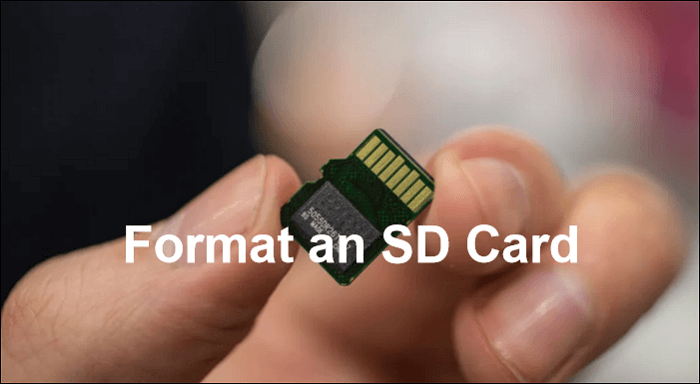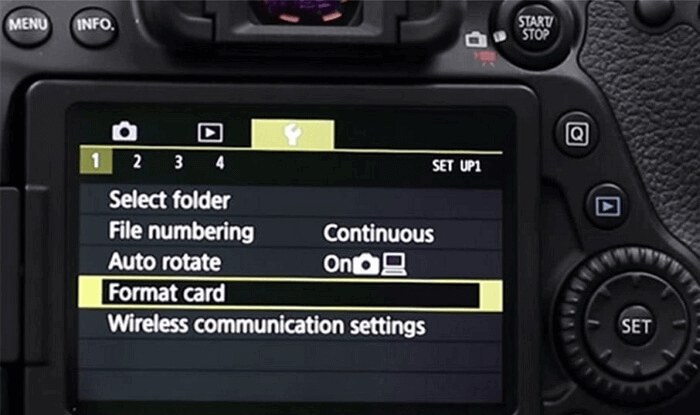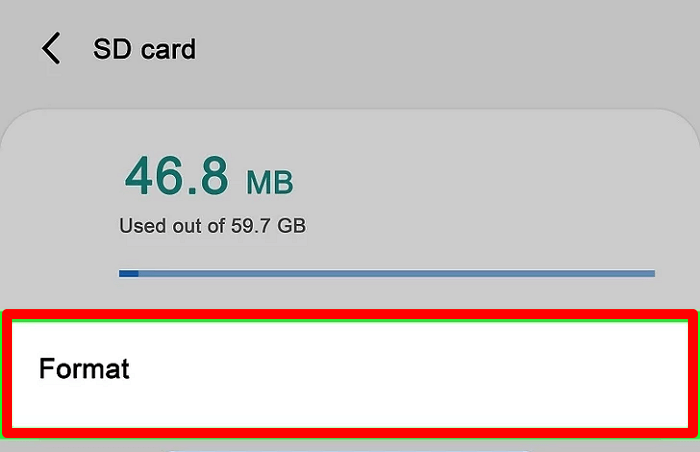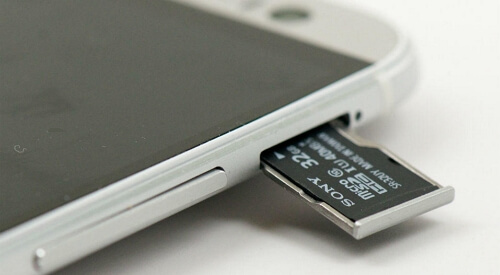SD cards are one of the popular storage solutions for different multimedia devices. The different uses of SD cards make them prone to damage like accidental damage or formatting issues. All these cases lead to loss of data on SD cards, which is not expected in devices like cameras. Hence, many users may look for solutions to why my camera is telling them to format their SD card.
Let us know all about this error message "format SD card" for the camera. We'll go through the key reasons behind this problem, followed by the top three methods to format SD cards for the camera without losing data. Readers will be able to solve this issue independently by the end of the article.
Why Is My Camera Telling Me to Format My SD Card
The SD card formatting message on the camera is an indication of its malfunction. The interrupted process of writing on the SD card, corrupted SD card, loss of camera or computer files for reading and writing purposes, etc., may press on the need to format the SD card. Why format SD card?

Some of the possible reasons for the camera showing the format of the SD card message are:
- SD card is complete without too many files: It is observed that the SD card may not contain many files but still show as full. Such cases ask for dedicated formatting to ensure the complete removal of the SD card data.
- SD card has stopped working: Any corrupted file or malware can cause the SD card to stop working. Hence, all you need to do is format it to start using it on your camera.
- SD card is incompatible: It is necessary to go for the SD card which is compatible with your camera. The mismatch of the file formats may cause incompatibility issues on the device.
Hence, whether the SD card is full, has stopped working, or is incompatible, it calls for dedicated formatting. All you need to ensure is that formatting doesn't result in accidental data loss.
By the way, you can click the following links to learn more about SD cards.
How to Format an SD Card for a Camera Without Losing Data
After learning about the key reasons for the camera showing format the SD card, it comes down to the top methods to format SD card for the camera. We've prepared a detailed list of the top three methods of formatting the camera's SD card without any data loss. These are:
- Method 1. Format SD Card for Camera in Windows
- Method 2. Format SD Card for Camera on Camera
- Method 3. Format SD Card for Camera in Android
Let us go through a detailed comparison between these methods based on different features. After going through the comparison table mentioned above, you may look for an effective tool to handle SD card formatting for the camera. EaseUS Partition Master Free is the easiest and best choice for formatting your SD cards for use in cameras.
| Feature | Format SD Card for Camera in Windows | Format SD Card for Camera on Camera | Format SD Card for Camera on Android |
|---|---|---|---|
| Safety |
|
|
|
| Speed |
|
|
|
| File System Types |
|
|
|
Let us go through these methods in detail. Now, let's start with Method 1.
Method 1. Format SD Card for Camera in Windows
EaseUS Partition Master is the one-stop solution for Windows users looking to format their SD card for the camera. It works smoothly on Windows XP, Windows Vista, and Windows 7/ 8/ 8.1 /10/ 11. It offers quick file format system conversions like NTFS/FAT32 to ensure the best file format system based on the device's requirements. Now, download it and follow the following guide to format the SD card.
Step 1. Select the USB drive to format.
Connect the USB drive or pen drive to your computer. Launch EaseUS partition software, right-click the USB drive you intend to format and choose "Format".
Step 2. Set the drive letter and file system on USB.
Assign a new partition label if you want to change the drive letter of your USB, set the desired file system -NTFS/FAT32/EXT2/EXT3/EXT4/exFAT to your USB, then click "OK".
Step 3. Check "Yes" to confirm formatting USB.
Click "Yes" if you see the Warning window. If you have important data on it, back up the data in advance.
Step 4. Apply the changes.
Click the "Execute 1 Task(s)" button first, and then click "Apply" to format the USB drive.
Windows beginners can use EaseUS Partition Master to format SD cards, adjust disk partition space, create partitions on USB drive, set up a hard drive, merge a partition, etc.
Features:
- It supports different file system types like exFAT, ReFS, FAT12/16/32, EXT 2/3/4, NTFS, etc.
- It supports storage devices like SD cards, USBs, SSD storage devices, HDD storage devices, SCSI, SATA RAID, IDE controllers, and RAIDed configurations.
- It is an all-in-one disk management tool for SD cards, external hard drives, USBs, etc.
- All its basic features are available in the free version, while professionals can upgrade to the paid plans based on their requirements for the advanced formatting features.
- It offers free technical support to the users in the event of any issues using the tool.
Method 2. Format SD Card for Camera on Camera
After learning about formatting SD cards for the camera in Windows using EaseUS Partition Master, it comes down to completing the formatting on the camera. First things first, it is essential to back up the files on the SD card on the computer or any other storage device. Once done, the quick steps for formatting the SD card for the camera on camera are:
Step 1. Insert the SD card while the camera is off.
Step 2. Turn on the camera.
Step 3. Go to the "Menu."
Step 4. Go to "Setup," and select "Format card." Press "Ok."

Step 5. The camera will take a few minutes to format the SD card and turn it off once done.
If SD card not working in camera, take it out and put the SD card into the camera again. Then, check if the problem has been removed.
Besides, if you don't have a camera right now, you can also format an SD card on an Android phone. Let's see how.
Method 3. Format SD Card for Camera in Android
After learning about formatting SD cards for cameras in cameras, it comes down to completing the formatting in Android. You can do it on your smartphone or any other device working on the Android operating system. The quick steps for the same are:
Step 1. Open the "Device Care" menu in the "Settings" of the Android device.
Step 2. Click on "Storage" followed by "Advanced."
Step 3. Go to "Portable Storage" and select SD card.
Step 4. Click on "Format" and "Format SD card."

Step 5. Restart the device to check if the SD card is formatted.
There is a link to help you if your SD card is not detected in your phone.
How to Fix SD Card Not Detected in Android Phone/Windows Error [New]
Here are the specific methods to make the SD card detected and repair undetected SD cards on your Android phone and PC without losing any data.

Conclusion
Hope everything is clear about why my camera is telling me to format my SD card problem. It is easy to understand the different reasons causing the camera to show the format of my SD card option. It can be an SD card full without enough data, an SD card stopped working, an incompatible SD card, etc.
The different methods to format SD cards for the camera without losing data in Windows, Camera, and Android. It is easy to go through these methods' detailed steps and key features. Even beginners can go through these methods to solve the problem of why my camera is telling them to format my SD card.
You may also like:
FAQs About Why Is My Camera Telling Me To Format My SD Card?
After going through the details about why my camera is telling me to format my SD card, you may have some questions. Let us help you with the top and frequently asked questions related to the same for quick help to our readers.
1. How do I fix my camera not reading my SD card?
It is easy to fix the camera not reading my SD card in the following way:
- Take the memory card out of the camera.
- Move the lock tab to the lock position temporarily
- Move the lock tab to the unlock position.
- Check if the memory card has any issues.
- Turn off the camera.
- Remove the insert of the memory card multiple times.
- Turn on the camera again to check if the problem is resolved.
2. How do I format my SD card back to normal?
The quick steps to format your SD card back to normal are as follows:
- Connect your SD card to the system using an SD card reader.
- Select "This PC" and open Windows Explorer.
- Right-click the SD card and select "Format."
- Select the file system and set a new label to the SD card.
- Click "Start" and "OK" to confirm the formatting.
3. Can you recover the formatted SD card canon?
The formatted SD card canon will contain the deleted files until new data overwrite it. Hence, a special SD card recovery software can recover the data from the formatted SD card canon.
4. Why does my camera say the card is not formatted?
The camera shows "card not formatted" if there is any physical or logical damage to the card. This can be due to the sudden halt of the SD card operations, the system's abrupt shutdown during SD card use, etc.
Was This Page Helpful?
Updated by Tracy King
Tracy became a member of the EaseUS content team in 2013. Being a technical writer for over 10 years, she is enthusiastic about sharing tips to assist readers in resolving complex issues in disk management, file transfer, PC & Mac performance optimization, etc., like an expert.
Sherly joined EaseUS in 2022 and she has always loved writing articles and enjoys the fun they bring. She receives professional training here, focusing on product performance and other relative knowledge. She has written over 200 articles to help people overcome computing issues.
Related Articles
-
[Solved!] How to Fix Windows 10 Activation Key Not Working
![author icon]() Jerry/2025-07-04
Jerry/2025-07-04 -
Mac Format SSD: How to Format SSD on Mac [Step-by-Step Guide]
![author icon]() Sherly/2025-07-04
Sherly/2025-07-04 -
How to Fix Windows 10 Not Using All RAM🔥
![author icon]() Jerry/2025-07-04
Jerry/2025-07-04 -
[Solved] System Image Recovery Not Showing
![author icon]() Jerry/2025-07-04
Jerry/2025-07-04
EaseUS Data Recovery Services
EaseUS data recovery experts have uneaqualed expertise to repair disks/systems and salvage data from all devices like RAID, HDD, SSD, USB, etc.